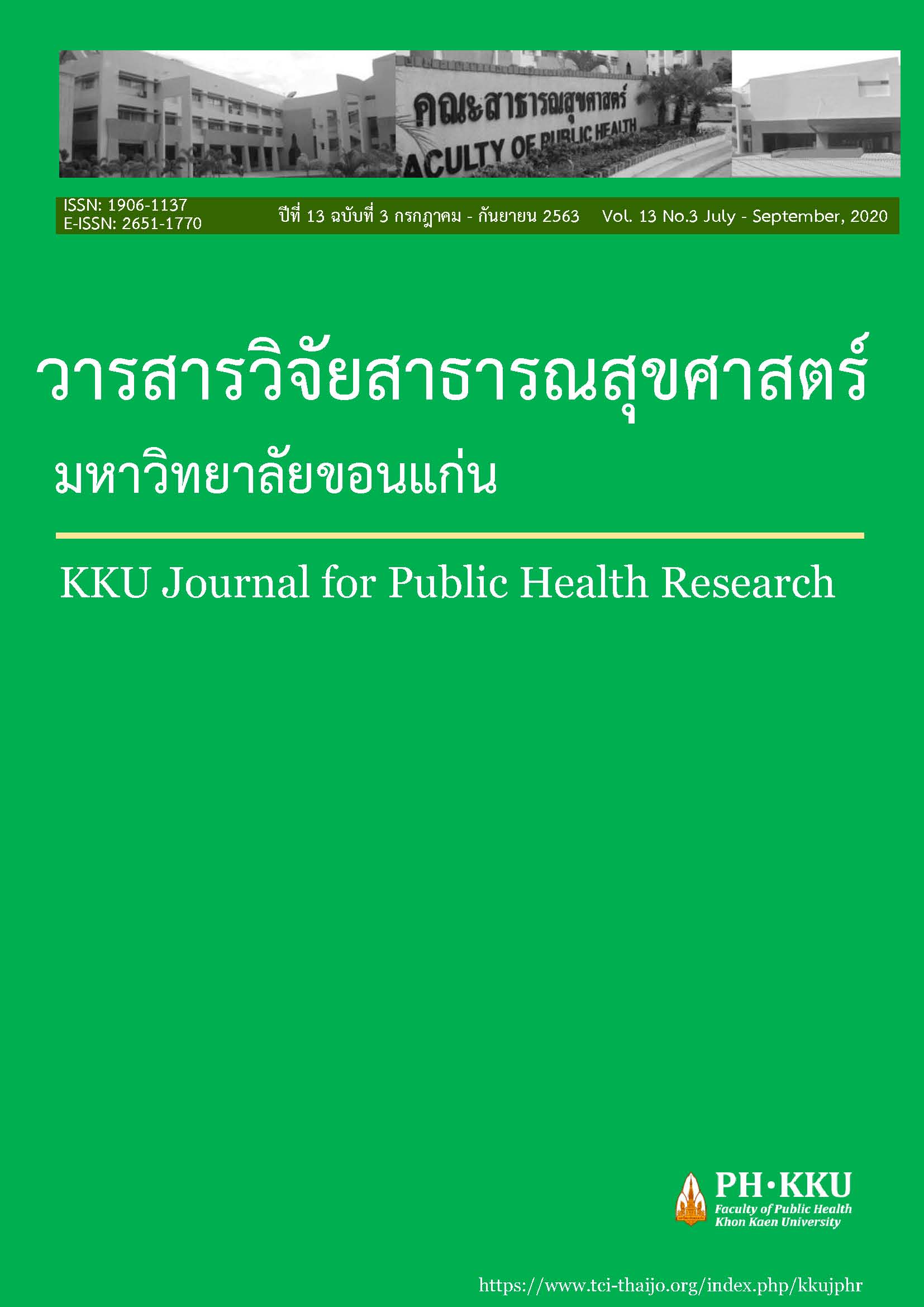Risk Assessment of Chlorination Disinfection Byproducts in Tap Water after Boiling and in Swimming Pool Water
คำสำคัญ:
Trihalomethanes (THMs), Haloacetic Acids (HAAs), Closed Boiler, Open Boiler, Inhalation, Ingestion, Skin Contactบทคัดย่อ
บทนำ งานวิจัยนี้มุ่งประเมินความเสี่ยงทางสุขภาพจากสารที่เกิดจากการฆ่าเชื้อโรคในน้ำด้วยคลอรีน (Chlorination Disinfection by-products, DBPs) จาก 2 แหล่งน้ำ(น้ำประปาที่ผ่านการต้ม และน้ำจากสระว่ายน้ำ)โดยช่องทางรับสัมผัสแตกต่างกันเนื่องจากมีรายงานถึงอันตรายต่อสุขภาพมาอย่างต่อเนื่องจากสาร DBPs วิธีวิจัย เก็บตัวอย่างน้ำประปาหลังต้มให้เดือดด้วยวิธีแตกต่างกันคือการต้มแบบเปิดฝาและการต้มแบบปิดฝาและเก็บตัวอย่างน้ำจากสระว่ายน้ำที่จุดเก็บตัวอย่างน้ำกลางสระและริมสระมาตรวจวิเคราะห์ โดย THMs (Trihalomethanes) ใช้ Purge and Trap, GC-ECD, ส่วน HAAs (Haloacetic acids) ใช้ LCMSMS แล้วทำการประเมินความเสี่ยง ผลการวิจัย งานวิจัยพบว่าการต้มโดยวิธีเปิดฝาจะลด THMs โดยการระเหยของสารได้ดีที่สุด การต้มแบบปิดฝาแล้วใช้วิธีการกดจ่ายน้ำออกจากหม้อต้มด้วยปั๊มลดสาร THMs ออกได้ดีรองลงมา และการต้มแบบปิดฝาแต่ไม่ได้ใช้วิธีการกดจ่ายน้ำออกจากหม้อต้มด้วยปั๊มจะลดสาร THMs ได้น้อยที่สุด การต้มน้ำซ้ำๆจะทำให้สารเคมีที่ระเหยได้และน้ำระเหยออกไปจนสารเคมีที่ระเหยได้น้อยมีความเข้มข้นเพิ่มขึ้นในน้ำ กรณีน้ำในสระว่ายน้ำงานวิจัยพบว่ามี THMs บริเวณขอบสระสูงกว่าบริเวณกลางสระ แต่กรณีสาร HAAs พบในน้ำประปาและน้ำสระว่ายน้ำในปริมาณที่ไม่มีนัยสำคัญ เมื่อประเมินอัตราเสี่ยงในการก่อมะเร็งตลอดชีวิต (Lifetime excess cancer rates) สำหรับกรณีความเสี่ยงด้านความเป็นพิษแบบไม่มีระดับกั้น (non-threshold toxicity) จากการใช้น้ำประปารวมจากหลายช่องทางรับสัมผัสพบว่าสูงเป็น 258-378 เท่าของอัตราเสี่ยงที่ยอมรับได้ซึ่งส่วนใหญ่เกิดจากช่องทางการกิน ส่วนอัตราเสี่ยงในการก่อมะเร็งตลอดชีวิตจากการรับสัมผัสน้ำในสระระหว่างว่ายน้ำสูงเป็น 1.24-1.93 เท่าของอัตราเสี่ยงที่ยอมรับได้ซึ่งส่วนใหญ่เกิดจากช่องทางการหายใจระหว่างว่ายน้ำ แต่กรณีความเสี่ยงด้านความเป็นพิษแบบมีระดับกั้น (threshold toxicity) ของน้ำจาก2แหล่งนี้อยู่ในระดับยอมรับได้ (acceptable range) สรุป ในการต้มน้ำควรปล่อยให้สารเคมีมีโอกาสระเหยออกไปได้เพื่อลดปริมาณ THMs ในน้ำ และควรหลีกเลี่ยงการต้มน้ำซ้ำๆเนื่องจากเป็นการทำให้สารเคมีซึ่งระเหยยากกว่าน้ำหรือสารเคมีไม่ระเหยมีความเข้มข้นมากขึ้น เมื่อว่ายน้ำควรหลีกเลี่ยงการว่ายน้ำบริเวณขอบสระ เพื่อลดความเสี่ยงด้านการก่อมะเร็ง การศึกษานี้ยืนยันว่ามีความเสี่ยงต่อการเกิดมะเร็งในระดับยอมรับไม่ได้จากการฆ่าเชื้อโรคในน้ำด้วยคลอรีนด้วยวิธีการที่ใช้อยู่ในปัจจุบันทั้งน้ำประปาและน้ำในสระว่ายน้ำ
เอกสารอ้างอิง
Agency for Toxic Substances and Disease Registry [ATSDR]. (2005). Public health assessment guidance manual (2005 update): Appendix G, calculating exposure doses. Retrieved June 30, 2016, from https://www.atsdr.cdc.gov/hac/phamanual/appg.html
Basu, M., Gupta, S. K., Singh, G., & Mukhopadhyay, U. (2011). Multi-route risk assessment from trihalomethanes in drinking water supplies. Environmental Monitoring and Assessment, 178(1-4), 121-134.
Chatsantiprapa, K, Kongngern, P, Thappasarasart, S. (2020). Risk Assessment of Disinfection Byproducts from Ingestion of Municipal Tap Water Supply in Khon Kaen, Thailand. KKU Journal for Public Health Research, 13(2), 77-92.
Dufour, A. P., Evans, O., Behymer, T. D., & Cantú, R. (2006). Water ingestion during swimming activities in a pool:
A pilot study. Journal of Water and Health, 4(4), 425-430.
Gough, R., Holliman, P. J., Willis, N., & Freeman, C. (2014). Dissolved organic carbon and trihalomethane precursor removal at a UK upland water treatment works. Science of the Total Environment, 468-469, 228-239.
Martí, V., De Pablo, J., Jubany, I., Rovira, M., & Orejudo, E. (2014). Water-Air Volatilization Factors to Determine Volatile Organic Compound (VOC) Reference Levels in Water. Toxics, 2(2), 276–290.
Moya, J., Howard-Reed, C., & Corsi, R. L. (1999). Volatilization of Chemicals from Tap Water to Indoor Air from Contaminated Water Used for Showering. Environmental Science & Technology, 33(14), 2321–2327.
Nuckols, J. R., Ashley, D. L., Lyu, C., Gordon, S. M., Hinckley, A. F., & Singer, P. (2005). Influence of Tap Water Quality and Household Water Use Activities on Indoor Air and Internal Dose Levels of Trihalomethanes. Environmental Health Perspectives, 113(7), 863–870.
Panyakapo, M., Soonthornchai, S., & Paopuree, P. (2008). Cancer risk assessment from exposure to trihalomethanes in tap water and swimming pool water. Journal of Environmental Sciences, 20, 372-378.
Pentamwa, P., Sukton, B., Wongklom, T., & Pentamwa, S. (2013). Cancer Risk Assessment from Trihalomethanes in Community Water Supply at Northeastern Thailand. International Journal of Environmental Science and Development, 4(5), 538–544.
Rahman, M. B., Driscoll, T., Clements, M., Armstrong, B. K., & Cowie, C. T. (2011). Effects of tap water processing on the concentration of disinfection by-products. Journal of Water and Health, 9(3), 507–514.
Risk Assessment Information System [RAIS]. (n.d). Risk assessment information system: Chemical data profiles. Retrieved Sep 17, 2018, from https://rais.ornl.gov/tools/profile.php
Rodriguez, M. J., Sérodes, J. B., & Levallois, P. (2004). Behavior of trihalomethanes and haloacetic acids in a drinking water distribution system. Water Research, 38(20), 4367–4382.
Siddique, A., Saied, S., Mumtaz, M., Hussain, M. M., & Khwaja, H. A. (2015). Multipathways human health risk assessment of trihalomethane exposure through drinking water. Ecotoxicology and Environmental Safety, 116, 129–136.
SizeThailand. (2007-2008). Survey of morphology whole country Thailand (2550-2551). Retrieved July 11, 2016, from http://www.sizethailand.org
Smith, J. H., Bomberger, D. C., & Haynes, D. L. (1980). Prediction of the volatilization rates of high-volatility chemicals from natural water bodies. Environmental Science & Technology, 14(11), 1332–1337.
Strenge, D. L., & Chamberlain, P.J. (1995). Multimedia Environmental Pollutant Assessment System (MEPAS): Exposure pathway and human health impact assessment models. Retrieved July 11, 2016, from https://mepas.pnnl.gov/mepas/formulations/exposure/vol5expo.pdf
United Nations. (2015). World population prospects: The 2015 revision, Key findings and advance tables. Retrieved July 11, 2016, from https://population.un.org/wpp/Publications/Files/Key_Findings_WPP_2015.pdf
United States Environmental Protection Agency [US. EPA]. (1987). Integrated Risk Information System (IRIS): Chemical assessment summary. Washington, DC: U.S. Environmental Protection Agency.
United States Environmental Protection Agency [US. EPA]. (1989). Risk assessment guidance for superfund. Washington DC: Human health evaluation manual.
United States Environmental Protection Agency [US. EPA]. (1991). Risk Assessment Guidance for Superfund (RAGS): Part B. RAGS part B guidance documents, Chapter 3 calculation of risk-based preliminary remediation goals. Retrieved June 13, 2016, from https://www.epa.gov/sites/production/files/2015-09/ documents/chapt3.pdf
United States Environmental Protection Agency [US. EPA]. (1992a). Dermal exposure assessment: Principles and applications. Office of health and environmental assessment. Washington, DC: U.S. Environmental Protection Agency.
United States Environmental Protection Agency [US. EPA]. (1992b). Guidelines for exposure assessment. Risk assessment forum. Washington DC: U.S. Environmental Protection Agency,
United States Environmental Protection Agency [US. EPA]. (2005). EPA Guidelines for Accurately Determining Volatile Organic Compound Concentration in Soil and Solid Matrices. Washington DC: U.S. Environmental Protection Agency,
United States Environmental Protection Agency [US. EPA]. [n.d.]. Integrated Risk Information System, US Environmental Protection Agency: IRIS Advanced Search. Retrieved Jul 21, 2016, from https://www.epa.gov/iris
Wang, G. S., Deng, Y. C., & Lin, T. F. (2007). Cancer risk assessment from trihalomethanes in drinking water. Science of The Total Environment, 387(1–3), 86–95.
Yee, L. F., Abdullah, P., Ata, S., Ishak, B., & Ehsan, S. D. (2006). Dissolved organic matter and its impact on the chlorine demand of treated water. The Malaysian Journal of Analytical Sciences, 10(2), 243-250.



